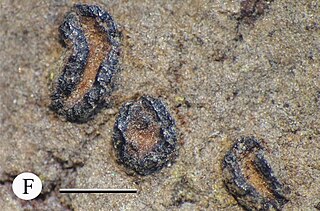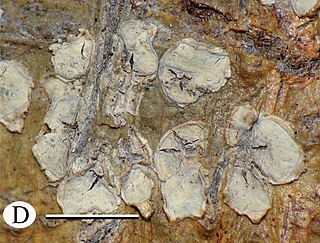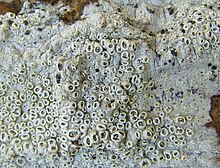
The Graphidaceae are a family of lichen-forming fungi in the order Graphidales. The family contains nearly a hundred genera and more than 2000 species. Although the family has a cosmopolitan distribution, most Graphidaceae species occur in tropical regions, and typically grow on bark.

Platythecium is a genus of lichen-forming fungi in the family Graphidaceae. It contains an estimated 27 species.

Fissurina is a genus of lichenized fungi in the family Graphidaceae. It has about 160 species, most of which are found in tropical regions.

Diorygma is a genus of lichen-forming fungi in the family Graphidaceae. The genus was circumscribed by Franz Gerhard Eschweiler in 1824. Species of the genus are widely distributed in tropical and subtropical regions of the world.

Acanthothecis is a genus of lichen-forming fungi in the family Graphidaceae. The genus was circumscribed by Frederick Edward Clements in 1909.

Myriotrema is a genus of lichen-forming fungi in the family Graphidaceae.
Melanotrema is a genus of lichen-forming fungi in the family Graphidaceae. The genus was circumscribed by German lichenologist Andreas Frisch in 2006, with M. platystomum assigned as the type species.
Leucodecton is a genus of lichen-forming fungi in the family Graphidaceae. The genus was circumscribed in 1860 by Swiss lichenologist Abramo Bartolommeo Massalongo, with Leucodecton compunctum assigned as the type species.
Chapsa is a genus of lichens in the family Graphidaceae. The genus was circumscribed by Italian lichenologist Abramo Bartolommeo Massalongo in 1860.
Phaeotrema is a genus of lichen-forming fungi in the family Graphidaceae. The genus was circumscribed in 1887 by Johannes Müller Argoviensis, with P. subfarinosum assigned as the type species.

Allographa is a genus of script lichens in the family Graphidaceae. It has nearly 200 species. Formally circumscribed in 1824 by François Fulgis Chevallier, Allographa was formerly included in Graphis, but was upgraded to generic status in 2018 by lichenologists Klaus Kalb and Robert Lücking.

Astrochapsa is a genus of lichen-forming fungi in the subfamily Graphidoideae of the family Graphidaceae. It has 28 species. The genus was circumscribed by Sittiporn Parnmen, Robert Lücking, and H. Thorsten Lumbsch in 2012, with Astrochapsa astroidea assigned as the type species. It was segregated from the genus Chapsa, from which it differs in having a more frequently densely corticate thallus, an apothecial margin that is mostly recurved, and the almost exclusively subdistoseptate, non-amyloid ascospores.
Wirthiotrema is a genus of lichen-forming fungi in the family Graphidaceae. The genus was circumscribed in 2010 by Eimy Rivas Plata, Klaus Kalb, Andreas Frisch, and H. Thorsten Lumbsch, with Wirthiotrema glaucopallens assigned as the type species. Wirthiotrema contains species that were formerly considered part of the Thelotrema glaucopallens species group. The genus name honours lichenologist Volkmar Wirth, "for his numerous outstanding contributions to lichenology".
Rhabdodiscus is a genus of script lichens in the family Graphidaceae. It has 36 species.
Schizotrema is a genus of lichen-forming fungi in the family Graphidaceae. The genus was circumscribed in 2009 by Armin Mangold and H. Thorsten Lumbsch.
Graphidales is an order of lichen-forming fungi in the class Lecanoromycetes. It contains 6 families, about 81 genera and about 2,228 species. Family Graphidaceae are the largest crustose family within Graphidales order comprising more than 2000 species, which are widely distributed in tropical and subtropical regions of the world.
Clandestinotrema is a genus of lichen-forming fungi in the family Graphidaceae. It has 17 species. They typically inhabit montane and cloud forest at higher elevations in the tropics.
Asteristion is a genus of lichen-forming fungi in the family Graphidaceae. It has seven species. Previously considered a synonym of either Phaeotrema or Thelotrema, molecular evidence led to its resurrection as a distinct genus. Asteristion lichens are corticolous (bark-dwelling), featuring a continuous thallus with a loose to hardened cortex and a photobiont layer containing calcium oxalate crystals. The ascomata, or fruiting bodies, are characterized by their large, often chroodiscoid appearance and the presence of distinct periphysoids. The secondary chemistry of these lichens includes major concentrations of stictic acid and minor to trace amounts of associated substances.








